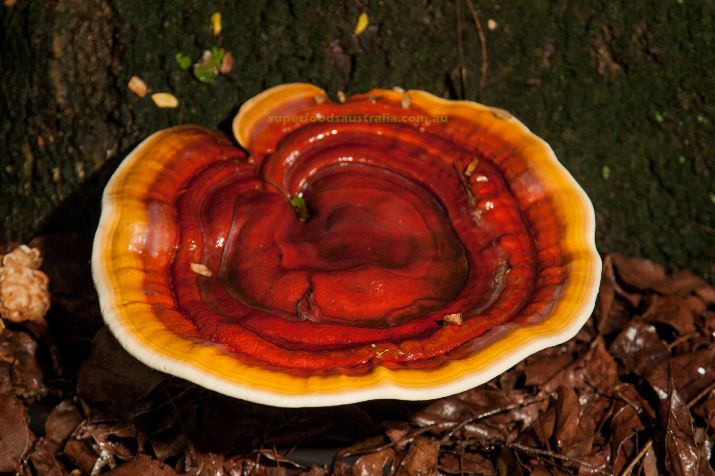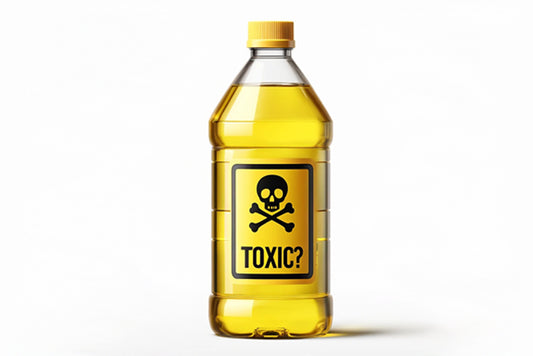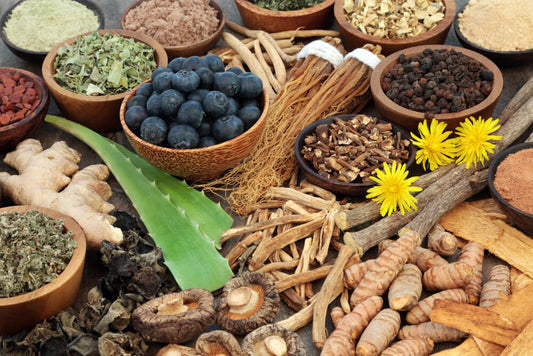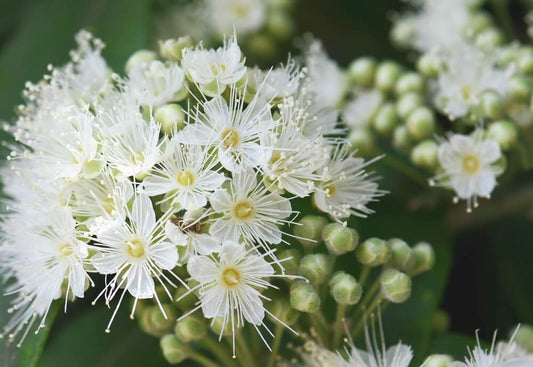
5 Superfood Mushrooms to Include in Your Stash
Whether you’re just a beginner or you were an early adopter of superfoods, here’s one thing that you should always take to heart: It’s not a legit superfood stash without any superfood mushroom in there.
So, if you’re expanding your collection of herbal teas, tinctures, and powdered extracts, make sure to put super mushrooms on top of your grocery list every time.
In this piece, we’re going to reveal the five super mushrooms that we think anyone who’s into superfoods and tonic herbalism must have in their stash.
But first, let's get this out of the way:
Are mushrooms really a superfood?
The answer is a big fat YES. You can never talk about superfoods without ever mentioning mushrooms.
In fact, they are the epitome of what a superfood really is: rich in nutritional benefits, with minimal calories, and packed with lots of medicinal properties.
Mushrooms have always been a staple in the culinary world as they are notoriously flavourful and gourmet worthy. Not to mention, they’re arguably the best pizza toppings of all time as well (fight us!).
However, make no mistake, mushrooms can offer more than just umami.
In recent years, more people are starting to see what many Asian traditional medicine experts from centuries ago have seen in these earthy fungi: the nutritional and medicinal prowess of mushrooms.
A little heads-up, though. Not all medicinal mushrooms with healing powers are appetizing and finger-licking good on their own. Don’t say we didn’t warn you!
The nutritional value of superfood mushrooms may vary depending on the species of fungi. But in general, edible mushrooms are great sources of what scientists call the four key dietary micronutrients for healthy aging: selenium, vitamin D, glutathione and ergothioneine.
These nutrients act as antioxidants that are all needed by the human body to help prevent oxidative stress, which occurs a lot as we age.
And, as you already know, oxidative stress is considered one of the main culprits in old-age diseases like cancer, heart disease, and dementia.
Aside from these micronutrients, mushrooms are also packed with other minerals and vitamins that help boost other aspects of our health. Given that, medicinal mushrooms are not just considered a superfood, but also the face of this entire food category.
So, if you’re planning to fill your pantry with the good stuff, below are some of the best examples of super mushrooms that you might want to include in your healthy stash.

Shiitake mushroom
If you order a slice of pizza with mushroom toppings, there’s a good chance that those brownish chewy toppings are shiitake mushrooms.
When diced or sliced, it can be challenging to recognize them on taste alone. But shiitake mushrooms are one of the easier superfood mushrooms that you can get your hands on in the freshest form.
Their caps and stems have this brown to tan colour while their gills are normally off-white. The umbrella-like caps can also grow up to ten inches with visible white cracks that indicate more flavour.
Aside from pizza toppings, shiitake mushrooms can also be used in a lot of different ways. Whether it’s for medicine or the kitchen. After all, shiitake mushrooms have gone a long way now since their discovery.
First discovered in East Asia, specifically in Japan, these mushrooms are now the world’s third most cultivated fungus, next to the white button and oyster mushrooms.
Originally, they grew on dead logs that you can find in forests. Shiitake literally means mushroom (take) that grows on the hardwood (shii).
However, as more mushroom cultivation techniques are invented, shiitake mushrooms can now be grown on corn cobs and sunflower seed hulls. making them more accessible to more people.
What does shiitake mushroom taste like?
Shiitake mushrooms are known for their umami taste and earthy flavour. And that’s mainly thanks to the amino acid glutamate that’s in the mushroom. It’s no wonder why Michelin-star chefs love to include shiitake on their menu.
Texture-wise, the umbrella-like caps of shiitake feel velvety or like actual meat.
The stems, on the other hand, are a different story. They can be incredibly hard to chew if not cooked right. But if cooked well enough, shiitake stems are pleasantly chewy in general.
Although shiitake sprouts from dead and decaying logs, it doesn’t translate to its health benefits in any way. It may even help you live longer and healthier, thanks to its nutritional composition.
These mushrooms are known for the main three compounds that can help lower your LDL, which can improve your heart health. They are as follows:
- Eritadenine
- Sterols
- Beta-glucans
Here’s how these compounds make wonders for your heart:
Eritadenine is responsible for inhibiting an enzyme that promotes the production of cholesterol. Sterols, on the other hand, impedes cholesterol absorption in your stomach. Lastly, beta-glucans are a type of fibre that helps lower cholesterol.
Aside from these compounds, shiitake mushrooms are also rich in other dietary fibres, copper, protein, iron, manganese, selenium, B vitamins, and vitamin D (if grown in the wild with sunlight).
Buy Australian Grown Shiitake Mushrooms here.

Lion’s mane mushroom
From the normal-looking mushroom that is shiitake, let’s now shift our focus on this notoriously weird-looking fungus: lion’s mane mushroom.
This fungus looks so unusual that it earned many equally unusual names as well. From hedgehog mushroom to monkey head mushroom, pom-pom mushroom, bearded tooth mushroom, and more!
But in Japan and China where this mushroom originated, it’s called yamabushitake and hou tou gu, respectively.
Since its discovery in the Asian rainforests over 2000 years ago, several countries are now growing this mushroom either in the wild or in cultivation facilities. And that’s mainly thanks to the standardization of its use in the 1950s.
Here in the Land Down Under, our Australian-grown mushrooms are cultivated in the rich lands of Yarra Valley in Victoria.
But aside from its natural breeding ground that is the forest, lion’s mane can also be grown commercially on beech sawdust, polypropylene bags, oak logs, and surprisingly, even brown rice.
Although lion’s mane is a mushroom of many names, one thing is for sure about this weirdly distinct fungus. It’s that it’ll be your next favourite superfood once you taste it and experience its health benefits firsthand.
Aside from its white and shaggy appearance, one of the many claims to fame of lion’s mane mushroom is its potential ability to boost cognitive health, mental function, memory, and concentration.
This is all thanks to the two special compounds called hericenones and erinacines which are responsible for the growth of nerve cells in the body.
A significant amount of these compounds may help older folks who are suffering from memory loss or any kind of decline in their mental functions.
Because of its ability to stimulate the growth of the nerve cells, the lion’s mane mushroom is also often linked to studies about the treatment of Alzheimer’s-related diseases.
What does lion’s mane mushroom taste like?
We know what you’re thinking: “Okay, it’s good for the brain, we get it. But does it even taste good?”
Well, if you’re quite a picky eater, including lion’s mane mushroom in your diet will not be a problem. It has a very seafood-like flavour. Lion’s mane reminds us of crab meat or lobster meat that is mildly sweet and has a chewy texture, just the way we like it!
If you want to have a taste of lion’s mane mushroom, check out some of our favourite lion’s mane mushroom recipes here.
If you’re not into cooking at all, you can still enjoy the health benefits of this super mushroom by simply intaking Lion’s Mane Extract 13:1 Extract Capsules or making a cuppa tea using our Lion’s Mane Mushroom Extract.
Check out and buy more Lion’s mane mushroom products here.

Chaga mushroom
If you think lion’s mane looks weird, then wait until you see the Chaga mushroom in person. Trust us, we’ve seen so many mushrooms in our lifetime, but we haven’t seen anything like this.
Although it grows mainly on the bark of the trees, like any other mushroom would, chaga still doesn’t even look or feel like a mushroom at all.
It looks like a clump of dirt attached to the bark, or a burnt part of the tree itself that measures around 25-38 centimetres. It feels like wood from the outside, but if you crush it in your hands, you’ll see that it has a really soft core inside.
Chaga mushroom was first discovered and used in Russia and other Northern European countries as traditional medicine.
It was normally grated into fine and raw Chaga powder then steeped into a tea. But nowadays, you can take it in as Chaga mushroom capsules or partner it with your go-to milk/mylk, coffee, or tea using the Siberian Chaga Tincture to get all the nutrition it has to offer.
Get your daily dose of antioxidants with chaga
When it comes to antioxidants, chaga mushroom is a powerhouse.
And if you’re not yet familiar with antioxidants, they are basically substances that we badly need to prevent, or at least slow down the cellular damage caused by free radicals in the body.
What are free radicals, you might ask? Well, they’re basically waste substances produced by the cells. And these free radicals often cause or at least promote skin aging, growth of cancer cells, inflammation, and many more.
That’s why we need antioxidants in the body. They flush out these wastes so that our cells would stay healthy and function normally.
Does chaga taste as weird as it looks?
There are things, especially any type of food or drinks, that don’t necessarily taste as you would expect them too based on their looks. Chaga mushroom is one of them.
It has a very distinct earthy flavour. It almost smells and tastes like tree bark, but not in a bad way. It’s mildly earthy that, sometimes, you might even fund it nutty or vanilla-ish.
If the chaga that you bought has a very strong earthy flavour (almost bitter), you might have bought a fake one.
Its pleasant and distinct taste is what makes a drop of chaga a great partner of coffee, tea, chocolate, or sometimes, even milkshakes!
For other delicious ways to use chaga, check here. And if you fancy these recipes that we whipped up, we don’t see any reason not to source this medicinal mushroom from us.
Buy chaga mushroom products here.

Reishi mushroom
Reishi mushroom, or lingzhi in China, is what people in the superfood community refer to as the “mushroom of immortality” or “elixir of life”.
And that’s mainly thanks to its two main components: polysaccharides and triterpenes which help promote good overall health wellness. But more on this later.
For many years, the reishi mushroom has been a staple medicinal mushroom in Eastern Asia. It was primarily used for treating infections back then.
But it has come a long way since it was first discovered and used 2000 years ago. In recent years, people have learned to maximise the nutritional power of reishi mushrooms.
Reishi mushroom is now used to boost immunity, combat fatigue, manage depression and more.
While this fungus prefers growing in both hot and humid areas in Asia, other countries have caught up to the reishi craze as well. Thanks to its amazing health benefits.
Strengthen your immunity with reishi
Despite its moniker, the reishi mushroom can never make humans immortal. But a regular dose of reishi goodness may certainly help you improve certain aspects of your health.
This is where the two main nutrients of reishi, polysaccharides and triterpenes, come into play.
Polysaccharides are chemical substances derived from plant foods like the reishi mushroom responsible for stimulating the white blood cells, thus, keeping your defence against diseases and infections in tiptop shape.
Triterpenes, on the other hand, are one of the components of reishi that can help lower blood pressure and LDL cholesterol levels.
Aside from this wonderful nutritional prowess, a cup of reishi mushroom tea or coffee can also help you relax whenever you’re under too much stress.
What does reishi mushroom taste like?
While reishi mushrooms can be eaten raw, it’s much more common to take this fungus in several forms like reishi mushroom soft gels or reishi mushroom powdered extract.
Aside from the convenience of it, this is partly because reishi mushroom has a very distinct and somewhat bitter taste. Which is not very appealing to some people.
Using reishi extracts instead of the raw ones means that you can partner it with delish recipes. This way, you can enjoy the food or drinks like tea or coffee that you already know and love, while still getting the nutritional benefits that reishi mushroom has to offer.
But if you’re curious what raw reishi mushroom tastes like, you can buy our Australian-grown reishi mushroom and see it for yourself!
Check out more reishi mushroom products here.

Cordyceps mushroom
If there’s a spectrum of weirdness, cordyceps mushroom is certainly on the farthest end. And it doesn’t get any weirder than this!
Instead of having bulbous, umbrella-like caps, cordyceps mushrooms, has long weird stems coming out of a dead caterpillar, or any other larvae.
Cordyceps is a type of parasitic fungus that’s mainly found in the mountains of Sikkim which borders India, Tibet, and Bhutan.
This fungus attacks the larvae of insects before replacing them with long and slender stems which grow outside the host. Cordyceps is basically a half-mushroom, half-dead bug.
The use of cordyceps mushroom was first recorded in Chinese and Tibetan medical books. The story was that local herders of yak, goat and sheep observed that their cattle were getting stronger by the day when they eat cordyceps as they grazed in the forests.
So, what they did was they collected the cordyceps, powdered them, then fed them to their cattle to increase their vitality, milk production, and overall wellness.
The story goes that they then tried the mushroom themselves and started to explore the nutritional benefits of cordyceps mushroom. Thousands of years later, here we are talking about the wonders that cordyceps mushrooms can do for your body.
Increase your energy with cordyceps
If you need a little pick me up to power through the day or your gym session, you can drink cordyceps tea or take cordyceps capsules in the morning or before you go.
Cordyceps can help to increase the production of adenosine triphosphate or ATP in the body, which is the molecule that delivers energy to our muscles, especially during exercise or any form of intense movement.
Aside from giving the energy that you need, cordyceps mushroom can also potentially help you fight aging, tumour, and diabetes as well.
Learn more about the amazing benefits of cordyceps mushrooms.
Does cordyceps mushroom taste good?
Don’t let the appearance of this larvae-eating mushroom fool you. It may look weird but it tastes just like most of the mildly sweet mushrooms out there. It has a certain umami to it with hints of earthy and nutty flavour.
Some even say that it tastes just like cacao! And we can’t blame them as cordyceps really finish with a sweet note.
There are a lot of recipes that you can make to enjoy the cordyceps mushroom goodness, from milkshakes to soup, truffles, coffee, and more. However, a hot cup of cordyceps mushroom tea is still the best in our books. It’s simply refreshing and reinvigorating.
But if you want to experiment a little on how you can fully incorporate cordyceps mushroom into your diet, you can hoard our cordyceps products and go play in the kitchen!
Buy cordyceps mushroom goods here.
Enjoy the 6-in-1 super mushroom goodness
Restocking your stash with all the superfood mushrooms in our collection is great. But here’s another thing that you don’t want to miss out on: Our organic 6 Mushroom Extract Elixir that has all the mushrooms that we mentioned here!
We combined all the powdered extracts of chaga, reishi, cordyceps, shiitake and lion’s mane, and maitake mushroom (also called as the "dancing mushroom") as a bonus!
Combining these 6 superfood mushrooms make a potent elixir that perfectly complements and boosts your daily morning coffee or afternoon tea.
Get this elixir and you’ll never make your favourite hot beverages fix the same way again!













